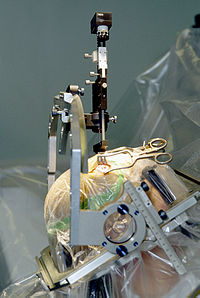
Photo from wikipedia
Introduction Percutaneous endoscopic lumbar discectomy (PELD) is a minimally invasive technique that has been used in different countries since the late eighties for the treatment of herniated discs. Objective The… Click to show full abstract
Introduction Percutaneous endoscopic lumbar discectomy (PELD) is a minimally invasive technique that has been used in different countries since the late eighties for the treatment of herniated discs. Objective The objective of this study was to describe the results of PELD in a series of awake patients, treated with epidural anesthesia and mild sedation. Materials and Methods In a group of 60 patients, who together had 77 discs operated on between April 2016 and March 2018, data were collected on patient age and gender, clinical presentation, and MRI abnormalities. The main outcome of interest was the difference between preoperative and postoperative Oswestry (Oswestry disability index [ODI]) scores 8 weeks after the procedure. Macnab criteria, operation duration, length of hospitalization, surgical complications, and the need for reoperation were other outcomes evaluated. All patients received epidural anesthesia and mild sedation. Results The average reduction in ODI at 8 weeks was 48 points (standard deviation [SD] = 5), representing an average percentage reduction of 85% (SD = 8). By Macnab's criteria, 85% of patients experienced either an excellent or good result, while 10% and 5% had a fair and poor result, respectively. Average surgery time was 50 min and in-hospitalization stay 8.6 h. Conclusions In our series of surgical patients with lumbar disc herniations, PELD yielded very good results, manifest as significantly reduced pain, brief procedural durations, no complications, and short hospital stays. Patients accepted the option of being awake and immediately ambulatory, and the approach proved highly feasible to execute.
Journal Title: Surgical neurology international
Year Published: 2019
Link to full text (if available)
Share on Social Media: Sign Up to like & get
recommendations!